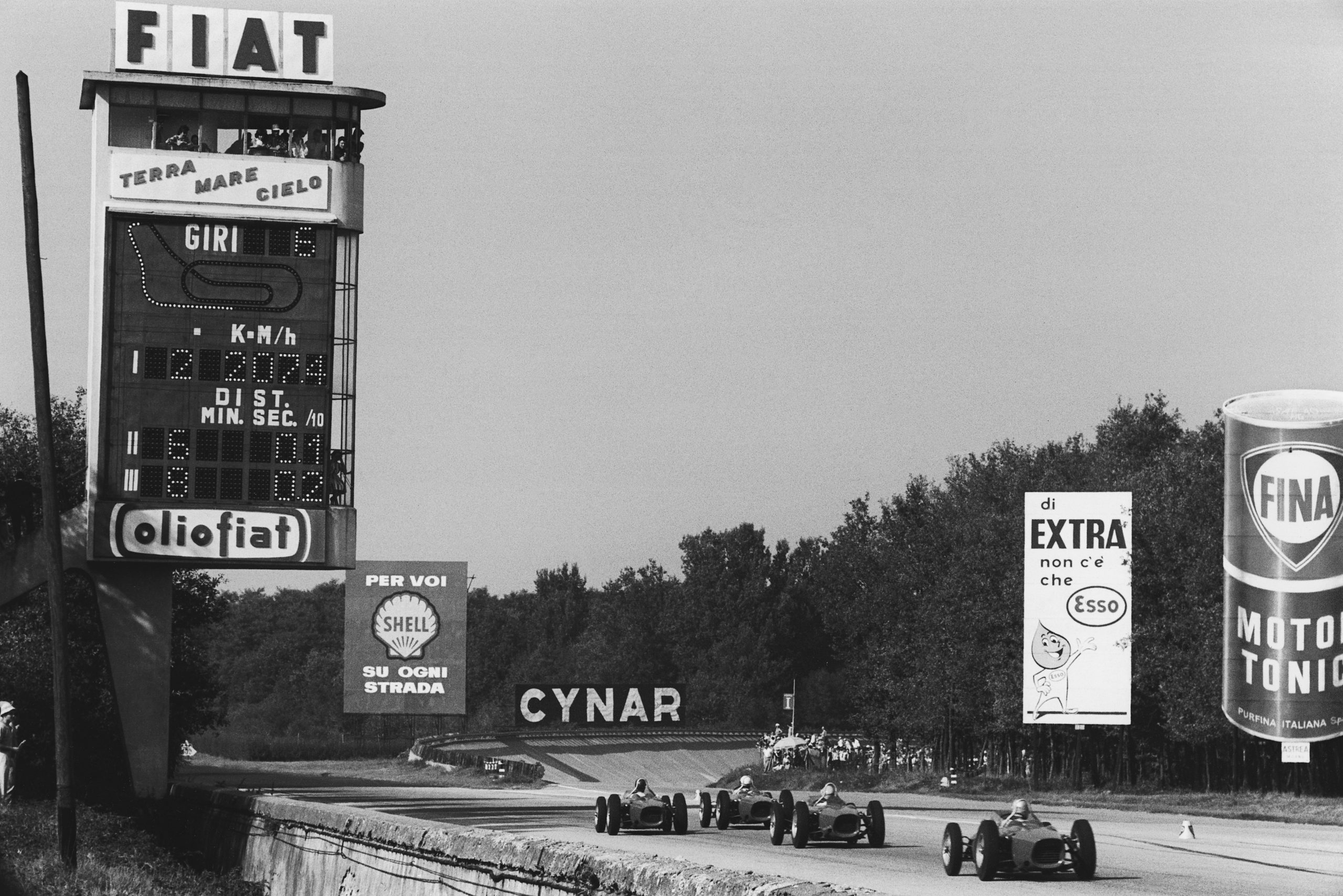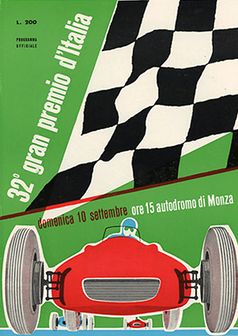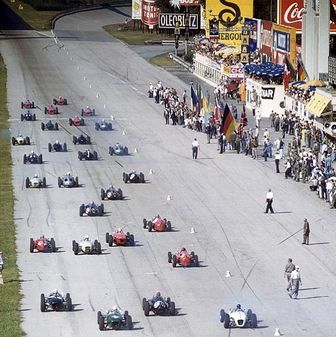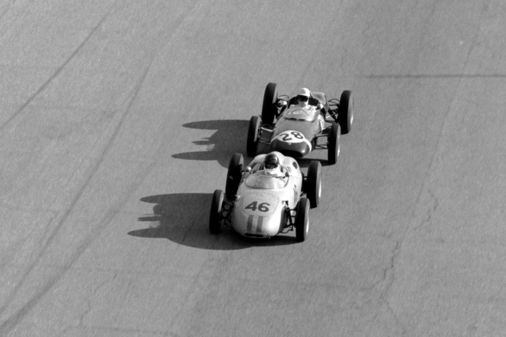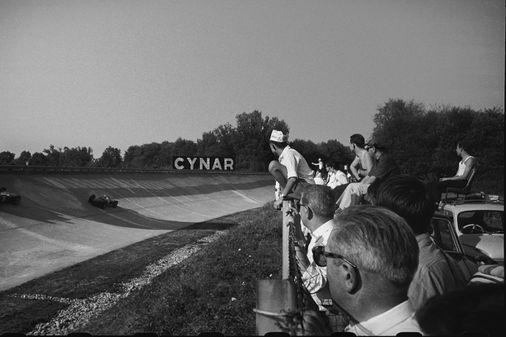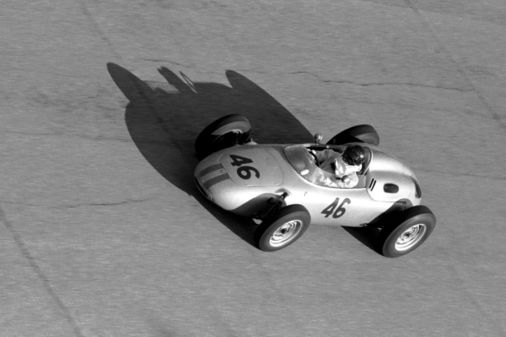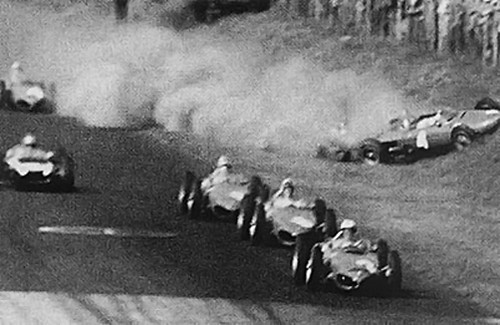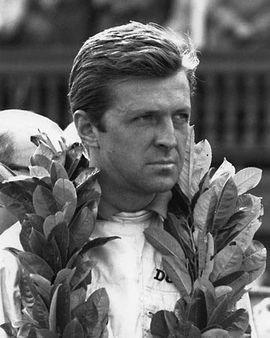1961 Italian Grand Prix (partially found footage of Formula One World Championship race; 1961)
The 1961 Italian Grand Prix was the seventh race of the 1961 Formula One Season. Occurring on 10th September at the Monza Circuit, the race would ultimately be won by Ferrari's Phil Hill, helping him claim his sole Drivers' Championship and become the first American to do so. However, the race is infamous for featuring the deadliest accident in Formula One history, which claimed the lives of Hill's teammate Wolfgang von Trips and 15 spectators.
Background
The 1961 Italian Grand Prix was the 11th running of the event as part of the Formula One calendar, with the race lasting 43 laps.[1] The 31st edition in Grand Prix history,[2] the Italian Grand Prix has been held at Monza for all bar one instance in 1980 since Formula One's inception in 1950,[3] and has garnered a reputation for being the "home" Grand Prix of Ferrari.[4]
The event would also marked the final instance of the Grand Prix utilising the full 6.2 mile version of the Monza Circuit and its banked section.[5][6][7][8] The British teams were unhappy racing at the 6.2 mile circuit, because they deemed the banked track too dangerous for racing, with the teams even boycotting the 1960 edition in protest.[5][6][8] This time, the British teams would compete as engines had been reduced to 1.5 litres, though they again voiced concerns regarding safety and expressed the desire to race on the road circuit.[5][6][8] The race organisers provided a partial compromise by reducing the distance from 50 to 43 laps.[8] Heading into the race, von Trips led Hill in the Drivers' Championship, with 33 points compared to 29.[9][8] The German therefore had the opportunity to secure the title at the event.[8] Lotus-Climax's Stirling Moss was in third with 21 points, and needed to win both the remaining races to stand any chance of winning the title.[7][8][9] Ferrari was also nearing its first Constructors' title prior to the event, with only Lotus having an outside chance of snatching the crown.[8][7][9] Additionally, the team would field a car for Ricardo Rodriguez, making his debut in the World Championship at only 19, despite Hill's concerns about his inexperience, stating "If he lives, I'll be surprised."[10][8][5][7][6]
Ferrari had gained an advantage for qualifying, as the team had conducted extensive testing back in August at the track.[5] All its cars posted times under 2:50, with von Trips achieving pole position with a time of 2:46.3.[5][7][6][1] A tenth behind in second was Rodriguez; by qualifying for the event at 19 years and 208 days, he became the youngest driver to start a World Championship event until the 2009 Hungarian Grand Prix, when Toro Rosso-Ferrari's Jaime Alguersuari qualified for the event at 19 years and 125 days.[10][7][5][8][1] His second place meant he also became the youngest to qualify for the front row, which lasted until the 2016 Belgian Grand Prix when Red Bull-Renault's Max Verstappen achieved the accolade at 18.[11] Ferrari's Richie Ginther and Hill ensured Ferrari had a 1-2-3-4 start, with BRM's Graham Hill starting fifth.[5][8][7][6][1] Moss qualified 11th out of 34 competitors, with the Rob Walker team having swapped their Lotus-Climax with a new V8 engine with a works Lotus four cylinder originally driven by Innes Ireland.[8][5][1]
The Race
With the starting order decided, the 1961 Italian Grand Prix commenced on 10th September.[1] Ginther and Lotus-Climax's Jim Clark made the strongest starts, with both battling for the lead ahead of Hill, Rodriguez, and von Trips, who made a poor start.[5][7][6][8][1] However, by the completion of lap 1, Hill had moved into the lead, with Clark dropping down to fifth after being passed by Rodriguez and von Trips.[8][5][7] He then duelled with von Trips, only for the pair to collide on the approach to Parabolica, causing the latter's fatal accident.[12][8][5][6][7][1] Giancarlo Baghetti in a privateer Ferrari, Cooper-Climax's Jack Brabham, and Porsche's Dan Gurney barely avoided the accident ahead.[5][12] Moss meanwhile moved into sixth but was struggling with handling and gearbox characteristics of the works Lotus.[5] As the race progressed, only Brabham kept up with the four Ferraris, with Hill and Ginther occasionally swapping the lead, Hill primarily being ahead.[5][8][1] However, Brabham retired on lap 9 after a water leak convinced him that retiring would preserve the Climax engine.[5][8][7][1]
The Ferraris were now 20 seconds ahead of Moss, who was duelling with Gurney.[5][7][6] However, Rodriguez retired after 13 laps following a fuel pump issue, with Baghetti also being eliminated on the same lap due to an engine failure.[5][6][8][7][1] This convinced Hill and Ginther that while a 1-2 was likely, reducing the pace would ensure their cars would make it to the end.[5] By lap 22, Moss was still ahead of Gurney, with both under 20 seconds behind the two Americans.[5][6] Just two laps later, Ginther became the latest Ferrari retirement, following an engine failure.[5][6][8][7][1] Now that Moss had dealt with the Porsche, he was now motivated to try and close the gap to Hill to keep his title chances alive.[5] However, Hill capitalised on having a new Ferrari engine by increasing the gap to 28 seconds.[5] Suddenly, Moss began to slow, firstly being overtaken by Gurney, before retiring on lap 37 as the left front-wheel bearing overheated and jammed.[6][5][8][7][1]
Thus, Hill claimed victory and with it eight points in the Drivers' Championship.[5][6][7][8][1] This moved him one point ahead of von Trips in the standings; with von Trips now deceased and with Moss unable to catch the American, it assured Hill would be the 1961 Formula One World Champion.[13][5][8][6][7] He became the first American to win the title, the other being Lotus-Ford's Mario Andretti in 1978.[14][6] However, the death of von Trips meant that celebration was muted overall.[8][5][6][7] Gurney was over 30 seconds behind in second, while Cooper-Climax's Bruce McLaren took third.[5][7][1] There was a close battle for fourth, with Cooper-Climax's Jack Lewis and BRM's Tony Brooks finishing together almost in a dead heat; it was later declared Lewis beat Brooks for fourth.[5][7][1] Cooper-Climax's Roy Salvadori would finish a lap down in sixth.[7][5][1]
The Deadliest Accident in Formula One History
On the opening lap, Lotus-Climax's Gerry Ashmore was approaching the Parabolica, but misjudged his speed, causing him to hit the outside grass bank and collide into the forest near the South Banking.[5][8] Ashmore survived, but suffered serious head injuries.[6][8] Despite the serious accident, racing continued.[6][8] The following lap, Clark was racing von Trips in a battle for fourth.[8][5] Halfway through the lap, Clark attempted an overtake, when von Trips moved across to the left-hand side of the track where the Scot was present.[8][5][6][12] The cars collided at around 140mph, with Clark having spun on the track before resting on the grass verge.[15][6][8][12] While he was shaken, the Scot survived unhurt.[8][6][7][12][15] He stated to reporters afterwards "Von Trips and I had been passing and re-passing each other. As we approached the bend, he was almost level with me on my right. He suddenly pulled right across in front of me, and although I had two wheels on the verge, a front wheel touched his rear wheel. What happened then, I don't know."[8][6][12] Brabham, who witnessed the collision, denied allegations that either driver was carving each other up leading up to the accident.[8]
Meanwhile, von Trips' Ferrari somersaulted, before proceeding to mount a banking where spectators were present.[8][12][6][15] Protected only by a chain fence, several spectators were hit by the Ferrari, which then flipped backed onto its wheels and onto the track, with Baghetti, Brabham, and Gurney narrowly avoiding the wrecked vehicle.[8][12][6][15] During the crash, von Trips was thrown free from his car, resulting in him breaking his neck.[16][8][12][6] He was taken to hospital, but was pronounced dead aged 33.[8][12][6] A German Count, von Trips was considered a natural motor racing talent, who although was prone to crashing in his early years of racing, would later be given the nickname "Taffy", presumably by 1958 World Champion Mike Hawthorn, with it being a Welsh slang word meaning a brave and fearless man.[16][12][8] He had the opportunity to gain the title at the event, but also expressed concerns about mortality to journalist Robert Daley a day before the race, telling him "It could happen tomorrow. That's the thing about this business. You never know."[8]
Aside from von Trips, eleven spectators were killed instantly in the accident.[12][15][8] A further four would perish in hospital in the following days, therefore bringing the final spectator death toll to fifteen, with many others injured.[12][15][8] To date, it is the deadliest accident to have occurred within Formula One's history.[12][8][15][6][7] As it was among a set of fatal accidents involving spectators that occurred between 1953 to 1961, it led to more demands for the banning of motorsport, while others were concerned that spectator safety was impossible without moving them too far away from the action.[8] Nevertheless, spectator safety has been enhanced significantly at Parabolica, with a double-height debris fence shielding the crowd.[8] Meanwhile, Ferrari, having secured both titles at the race, withdrew from the United States Grand Prix out of respect for the deceased.[8][6]
Availability
Footage and photos of the race and the fatal accident is widely available to view in documentaries and newsreels.[15] However, television coverage of the race remains missing; this includes four live airings of the race as part of the Eurovision Network, lasting around an hour and ten minutes.[17] Additionally, Issue 1,974 of Radio Times states that the BBC provided highlights on the same days as part of Sportsview, with the 35 minute broadcast also containing a preview of a 1961 European Cup match between Gornik and Tottenham Hotspur, and a report of a rugby league match between Lancashire and New Zealand.[18][17] No television broadcast has fully resurfaced, but a fragment of the Eurovision Network coverage was included in a documentary.
Gallery
Videos
Images
See Also
- 1953 British Grand Prix (partially found footage of Formula One World Championship race; 1953)
- 1953 Italian Grand Prix (partially found footage of Formula One World Championship race; 1953)
- 1954 British Grand Prix (partially found footage of Formula One World Championship race; 1954)
- 1954 Italian Grand Prix (partially found footage of Formula One World Championship race; 1954)
- 1955 Dutch Grand Prix (partially found footage of Formula One World Championship race; 1955)
- 1955 Italian Grand Prix (partially found footage of Formula One World Championship race; 1955)
- 1955 Monaco Grand Prix (partially found footage of Formula One World Championship race; 1955)
- 1956 Belgian Grand Prix (partially found footage of Formula One World Championship race; 1956)
- 1956 British Grand Prix (partially found footage of Formula One World Championship race; 1956)
- 1956 French Grand Prix (partially found footage of Formula One World Championship race; 1956)
- 1956 Italian Grand Prix (partially found footage of Formula One World Championship race; 1956)
- 1956 Monaco Grand Prix (partially found footage of Formula One World Championship race; 1956)
- 1957 British Grand Prix (partially found footage of Formula One World Championship race; 1957)
- 1957 Monaco Grand Prix (partially found footage of Formula One World Championship race; 1957)
- 1958 British Grand Prix (partially found footage of Formula One World Championship race; 1958)
- 1958 French Grand Prix (partially found footage of Formula One World Championship race; 1958)
- 1958 Italian Grand Prix (partially found footage of Formula One World Championship race; 1958)
- 1958 Monaco Grand Prix (partially found footage of Formula One World Championship race; 1958)
- 1958 Moroccan Grand Prix (partially found footage of Formula One World Championship race; 1958)
- 1959 British Grand Prix (partially found footage of Formula One World Championship race; 1959)
- 1959 Italian Grand Prix (partially found footage of Formula One World Championship race; 1959)
- 1959 Monaco Grand Prix (partially found footage of Formula One World Championship race; 1959)
- 1959 Portuguese Grand Prix (partially found footage of Formula One World Championship race; 1959)
- 1960 British Grand Prix (partially found footage of Formula One World Championship race; 1960)
- 1960 French Grand Prix (partially found footage of Formula One World Championship race; 1960)
- 1960 Monaco Grand Prix (partially found footage of Formula One World Championship race; 1960)
- 1960 Portuguese Grand Prix (partially found footage of Formula One World Championship race; 1960)
- 1961 Belgian Grand Prix (partially found footage of Formula One World Championship race; 1961)
- 1961 Dutch Grand Prix (partially found footage of Formula One World Championship race; 1961)
- 1961 French Grand Prix (partially found footage of Formula One World Championship race; 1961)
- 1961 Monaco Grand Prix (partially found footage of Formula One World Championship race; 1961)
- 2005 San Marino Grand Prix (partially found ITV advert break during final laps of Formula One race; 2005)
- Advanced Driving with Graham Hill (lost ITV motoring series; 1974)
- Angelo Orsi's photos of Ayrton Senna (lost photos of Formula One driver post-crash; 1994)
- Anthoine Hubert and Juan Manuel Correa (partially found FOM footage of fatal Formula 2 crash; 2019)
- Ayrton Senna (partially lost on-board video of fatal Formula One crash; 1994)
- Donkey Does F1 (partially found photos of Shrek character inflatable at Formula One races; 2004)
- F-1 World Grand Prix III (lost build of cancelled Nintendo 64 Formula One racing game; 2000-2001)
- F1 2000 (lost pre-release builds of Formula One game; 2000)
- F1 2010 (lost pre-alpha build of Formula One game; 2010)
- F1 Racing Championship 2 (lost build of cancelled PC/PlayStation 2 Formula One game; 2001)
- Fernando Alonso's 2015 testing accident (lost footage of Formula One test session crash; 2015)
- Grand Prix 3 (lost build of cancelled Dreamcast port of PC Formula One racing game; 2001)
- Grand Prix 4 (lost build of cancelled Xbox port of PC Formula One racing game sequel; 2002)
- Jules Bianchi (lost FOM footage of fatal Formula One crash; 2014)
- María De Villota (lost footage of fatal Formula One crash; 2012)
- McLaren MP4-18 (lost footage of unraced Formula One car; 2003)
- Michael Schumacher (lost photo of Formula One driver post-skiing accident; 2016)
- Neil Shanahan (lost footage of fatal British Formula Ford Zetec Championship crash; 1999)
- Paul Warwick (lost footage of fatal British F3000 crash; 1991)
- Racing Arrows (partially found Formula One TV series; 2001)
- Robert Kubica's 2010 Japanese Grand Prix Q3 lap (lost audio of Formula One qualifying lap; 2010)
- Williams FW15C (partially found footage and lap time information of unraced CVT Formula One car; 1993)
References
- ↑ 1.00 1.01 1.02 1.03 1.04 1.05 1.06 1.07 1.08 1.09 1.10 1.11 1.12 1.13 1.14 1.15 1.16 Racing-Reference detailing the qualifying and race results of the event. Retrieved 28th Sep '22
- ↑ Ultimate Car Page listing all instances of the Italian Grand Prix. Retrieved 28th Sep '22
- ↑ F1 Experiences detailing facts regarding the Italian Grand Prix. Retrieved 28th Sep '22
- ↑ Scuderia Ferrari Club detailing how Monza is considered the home of Ferrari. Retrieved 28th Sep '22
- ↑ 5.00 5.01 5.02 5.03 5.04 5.05 5.06 5.07 5.08 5.09 5.10 5.11 5.12 5.13 5.14 5.15 5.16 5.17 5.18 5.19 5.20 5.21 5.22 5.23 5.24 5.25 5.26 5.27 5.28 5.29 5.30 5.31 5.32 Motor Sport providing a detailed race report. Retrieved 28th Sep '22
- ↑ 6.00 6.01 6.02 6.03 6.04 6.05 6.06 6.07 6.08 6.09 6.10 6.11 6.12 6.13 6.14 6.15 6.16 6.17 6.18 6.19 6.20 6.21 6.22 6.23 6.24 6.25 6.26 6.27 6.28 ESPN summarising the race. Retrieved 28th Sep '22
- ↑ 7.00 7.01 7.02 7.03 7.04 7.05 7.06 7.07 7.08 7.09 7.10 7.11 7.12 7.13 7.14 7.15 7.16 7.17 7.18 7.19 7.20 7.21 7.22 Grand Prix summarising the event. Retrieved 28th Sep '22
- ↑ 8.00 8.01 8.02 8.03 8.04 8.05 8.06 8.07 8.08 8.09 8.10 8.11 8.12 8.13 8.14 8.15 8.16 8.17 8.18 8.19 8.20 8.21 8.22 8.23 8.24 8.25 8.26 8.27 8.28 8.29 8.30 8.31 8.32 8.33 8.34 8.35 8.36 8.37 8.38 8.39 8.40 8.41 8.42 8.43 Race Fans documenting the race and the disaster. Retrieved 28th Sep '22
- ↑ 9.0 9.1 9.2 Stats F1 detailing the Drivers' and Constructors' Championship standings heading into the race. Retrieved 28th Sep '22
- ↑ 10.0 10.1 Motorsport Memorial detailing the life and career of Rodriguez, including him becoming the youngest driver to compete at a World Championship event until 2009. Retrieved 28th Sep '22
- ↑ NBC Sports noting Rodriguez was the youngest to qualify on the front row of a World Championship race until 2016. Retrieved 28th Sep '22
- ↑ 12.00 12.01 12.02 12.03 12.04 12.05 12.06 12.07 12.08 12.09 12.10 12.11 12.12 12.13 Motorsport Memorial page for Wolfgang von Trips. Retrieved 28th Sep '22
- ↑ Stats F1 detailing the Drivers' and Constructors' Championship standings following the race. Retrieved 28th Sep '22
- ↑ F1-Fansite detailing the list of Formula One World Champions by year and nationality. Retrieved 28th Sep '22
- ↑ 15.0 15.1 15.2 15.3 15.4 15.5 15.6 15.7 The Crash Photos Database detailing the accident and providing photos of it. Retrieved 28th Sep '22
- ↑ 16.0 16.1 ESPN detailing von Trips and his "Taffy" nickname. Retrieved 28th Sep '22
- ↑ 17.0 17.1 List of Formula One television broadcasts noting the partial live broadcasts as part of the Eurovision Network, and the same-day BBC highlights. Retrieved 28th Sep '22
- ↑ BBC Genome archive of Radio Times issues detailing the BBC coverage of the race as part of Sportsview. Retrieved 28th Sep '22

